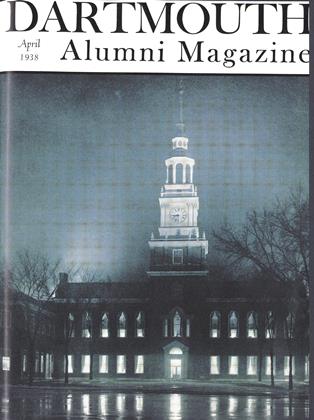by John Henry Bartlett '94. M. A. Donohue & Company, Chicago, 1937. P. $2.00.
This is the story of the Battle of the Anacostia Flats, which took place on July 28, 1933 between the men, women, and children of the Bonus Expeditionary Force and the United States Army. It is the story of the events leading up to the tragic pilgrimage of the Bonus Marchers, of their eight weeks encampment in the shadow of the Capitol Building, and of their forceful eviction by four full companies of the United States Infantry. It is, finally, the story in brief of the repercussions of this "battle" upon the Hoover Administration m the presidential election which was only a few short months away.
John Henry Bartlett is a former Governor of New Hampshire who was living in Washington at the time of the Bonus March. His sympathies were so aroused by the plight of the veterans that he donated "Camp Bartlett" as a temporary sanctuary for them during their stay in Washington. Some of them were able to take advantage of his offer, but the majority remained in the unused park on the Anacostia flats, whence they were ejected by the Army.
The explicit thesis of the author is that the eviction of the Bonus Expeditionary Force did much to dramatize the need for Federal funds for unemployment relief throughout the country. The insistence of President Hoover on the policy of local care for all relief was, in Mr. Bartlett's estimation, a major factor in his subsequent defeat. The veterans were thus cast in the unfortunate role of precipitating agents in the social process which eventually brought Federal funds for unemployment relief. [ln the author's own words, "That now famous pilgrimage to the Capital, with all its alarm and tragedy, so dramatized the President's harsh economic policy that it was repudiated by the people."] The Bonus Marchers asked for the Bonus in 1932. They did not get it then, but they did win, in Mr. Bartlett's opinion, the principle of Federal responsibility for the millions of unemployed who were even less articulate than themselves.
The January first issue of The WeeklyUnderwriter contains an article by Harold P. Jackson '10 entitled Making Irresponsible Drivers Responsible.
Effect of Light on CO2 in Leaves by John Shafer Jr. '33 was printed in the January, 1938 number of Plant Physiology. The author held one of the Cramer Fellowships while conducting this research.
The Strumpet Sea by Ben Ames Williams '10 will be reviewed in a later issue of the MAGAZINE.
William W. Harris '28 has revised the 1937 edition of Harry L. Foster's companionable handbook for the traveler, IfYou Go to South America, published by Dodd Mead & Company. Mr. Harris has provided this informative guide with illustrative material of high photographic quality, with the latest information on routes and hotel accommodations, and with up-to-date figures on costs. It may be encouraging to the prospective traveler in South America to find out that the figures for the minimum fare and shore expenses of a tour including the West and East Coasts and the transandine trip from Santiago to Buenos Aires have become smaller, although not enough still to stand comparison with those for the well-beaten North Atlantic lanes to Europe.
 View Full Issue
View Full Issue
More From This Issue
-
 Article
ArticleIn Search of Snow Down Under
April 1938 By DAVID J. BRADLEY '38 -
 Article
ArticleThe Potentialities of Education
April 1938 By FREDERICK E. WAGNER '38 -
 Article
ArticleThe Undergraduate Chair
April 1938 By BEN AMES WILLIAMS JR. '38 -
 Class Notes
Class NotesClass of 1937
April 1938 By Donald C. McKinlay -
 Class Notes
Class NotesClass of 1910
April 1938 By Hap Hinman -
 Class Notes
Class NotesClass of 1934
April 1938 By Martin J. Dwyer Jr.
Francis E. Merrill '26.
-
 Sports
SportsWith Big Green Teams
February 1945 By Francis E. Merrill '26. -
 Books
BooksTHE GREAT CONSPIRACY,
March 1946 By Francis E. Merrill '26. -
 Sports
SportsLACROSSE
June 1946 By Francis E. Merrill '26. -
 Sports
SportsTENNIS
June 1946 By Francis E. Merrill '26. -
 Sports
SportsDartmouth 7, Yale 4
February 1947 By FRANCIS E. MERRILL '26. -
 Sports
SportsDartmouth 14, Clarkson 2
February 1947 By FRANCIS E. MERRILL '26.
Books
-
 Books
BooksNotes on medieval beasts and the versatile writer who modernizes them, and memorials for a Dartmouth organist.
March 1977 -
 Books
BooksWILLIAM HOWARD TAFT
January, 1931 By Charles R. Lingley -
 Books
BooksThe New Reservation of Time
February 1917 By HENRY T. MOORE -
 Books
BooksTHIS THING CALLED FREEDOM.
DECEMBER 1970 By JOHN HURD '21 -
 Books
BooksREADINGS IN THE FAMILY
March 1935 By R. P. Holben -
 Books
BooksO NEGRO NA FICCAO BRASILEIRA.
JANUARY 1967 By RONALD C. TURNER

